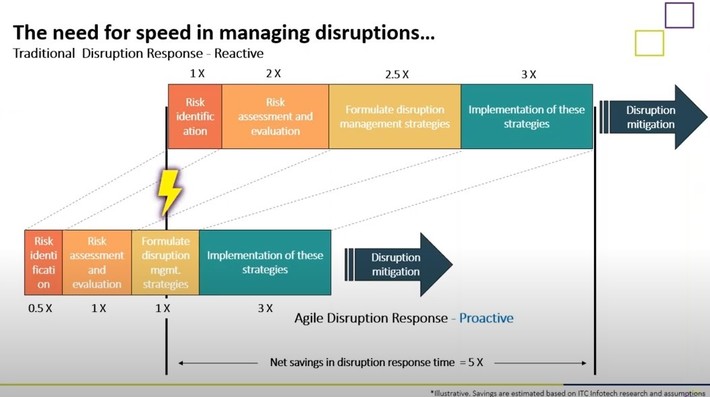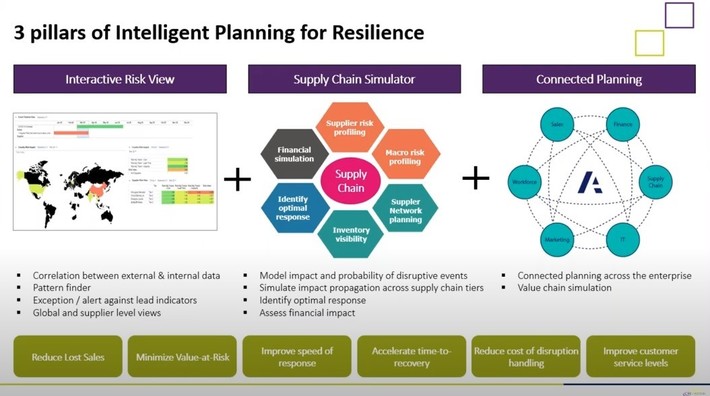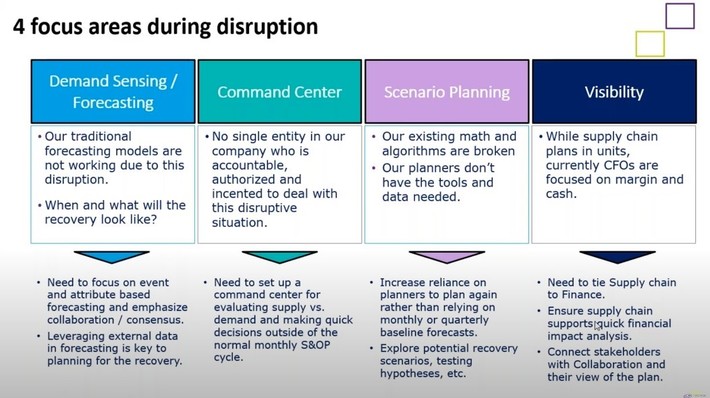
Supply chain disruptions are anything but uncommon. 2018 saw 2,629 disruption events being reported.[i] In 2019, 51.9% of firms experienced supply chain disruptions, with 10% experiencing six or more disruptions.[ii] Largely, these were man-made (79%). Most had a low severity (63%). Over time it has become evident that the ability of organizations to negotiate medium to high disruptions (37%) is low. In 2019, the impact of this inability was a loss of ¬ 100 M for 1 in 20 organizations, with the average annual cost of disruption being ¬ 10.5 M.[iii] Significantly, on average it took organizations 28 weeks to recover from the disruption.[iv] The numbers dont reveal the entire picture. But in themselves, they indicate a lack of resilience and an urgent need for organizations to predict, assess and mitigate disruptions with greater agility.
The real picture is that the cost of disruption is being under-reported. For many organizations the ability to accurately compute the cost of response, opportunity cost, and reputational damage are absent. The gaps in capability go beyond this. While most organizations can negotiate minor disruptions through safety stocks and long-term contracts, it is disruptions with higher severity and frequency that present overwhelming challenges. These gaps can be bridged by:
- Creating early warning capabilities
- Anticipating the impact of events on supply chains
- Understanding the financial impact and transmitting it across value chains
The essence of resilience
The only way to beat todays volatility and unpredictability are to bring speed and agility through connected, real-time systems. Organizations take days to realize they have been hit by disruption, board room discussion on risk assessment, and to formulate management strategy run into another handful of days (see Figure 1 for the net saving in response time that can be achieved between traditional and agile responses to disruption). All the while the organization is bleeding, losing business, customers, and reputation. Reducing the response time from 28 weeks to 16 weeks is the essence of building resilience in supply chain planning.

Figure 1
Modern technology can help crash time-to-respond by almost 60%, enabling faster risk simulation and helping prepare an optimal response. This is easier said than done. Most organizations are stumped by the roadblocks they face to resilience. Bob Debicki, Senior Director, CPG & Retail, Anaplan, says that Organizations are ill-equipped to handle disruption. Debicki observes that only 22.6% of organizations use technology to map full tier-n networks. This means there is a severe lack of visibility into what is happening within supply chains. 73% of organizations still rely on spreadsheets to manage supply chain risks, indicating that applying intelligent technology can make a dramatic change and build resilience. Organizations can change their approach by building:
- Communication and visibility through supplier and trading partner collaboration
- Establishing interlinkages across n-tier supply networks
- Creating early sensing capability by extracting insights from systems of records
- Using technology for rapid simulation and scenario planning ahead of disruptions using a more granular level of information accessible with higher frequency
- Enabling a cohesive response to disruptions through a connected planning ecosystem
But many businesses are getting comfortable with the existing baseline for forecasting. Unfortunately, that baseline is no longer valid in light of the disruption created by the COVID-19 pandemic. Early sensing capabilities using real-time information coupled with granular information (down to SKU and location) have become essential if organizations are to survive the shock of events such as the outbreak of COVID-19.
Breaking out of siloes
Many of the required capabilities to withstand extreme disruption already exist within organizations. But they exist in siloes. Organizations need to bring all their capacities and data onto a single platform to create the perfect response.
By converging the data organizations can build the three pillars of intelligent planning central to resilience (see figure 2 for details): deep visibility into the supply chain that helps develop an interactive view of risk, the ability to simulate scenarios, and the ability to respond through connected planning. The goal of convergence should be to sense fast, simulate, assess the impact on supply chains and bottom lines, and respond at speed with optimal mitigation strategies.

Figure 2
What should organizations focus on during disruptions such as those triggered by COVID-19? There are four focus areas we recommend: demand sensing, accountability, new tools for planners that go beyond existing algorithms, and connecting stakeholders (see figure 3 for details of the 4 focus areas during disruption)

Figure 3
The smart supply chain solution for complete resilience
Smart organizations are building resilience by connecting their systems to internal and external data sources, to other business areas such as finance, and integrating with real-time data services. Customers with an eye on the future are using ITC Infotechs supply chain solutions to use data to arrive at risk scores for potential disruptions, understand the severity of the event, and simulate scenarios for any risk ranging from power outages to supplier bankruptcy, labor shortages, natural disasters, political upheavals (example: Brexit), foreign exchange rate fluctuations, etc. The ITC Infotech system’s dashboards show supplier performance (defect rate, productivity, etc.) and ranking to identify potential problems such as cost escalations, impact on lead times, and capacity. Supply chain teams can simulate a variety of parameters such as event probability and duration of the event to reach accurate decisions related to managing shortfall, order plans, etc.
As pressure on organizations growsas it is bound to even after COVID-19 is past usthere will be a need to get on the path of dynamic supply chains. These can make granular adjustments in real-time using scenario-based forecasting.
A complete shift in perspective is necessary, from history-based forecasting to lead indicator-based decision-making through a connected and collaborative system. The future of agile supply chain systems has been cast. The faster organizations embrace intelligent planning, the more they will be able to face extreme disruptions with ease.
[i] https://info.resilinc.com/eventwatch-2018-annual-report
[ii] https://www.thebci.org/resource/bci-supply-chain-resilience-report-…
[iii] https://www.thebci.org/resource/bci-supply-chain-resilience-report-…
[iv] https://info.resilinc.com/eventwatch-2018-annual-report
Author Details:
Bob Debicki,
Sr Director, CPG & Retail,
Anaplan
Amit Paul
Senior Principal Consultant,
ITC Infotech India Ltd
